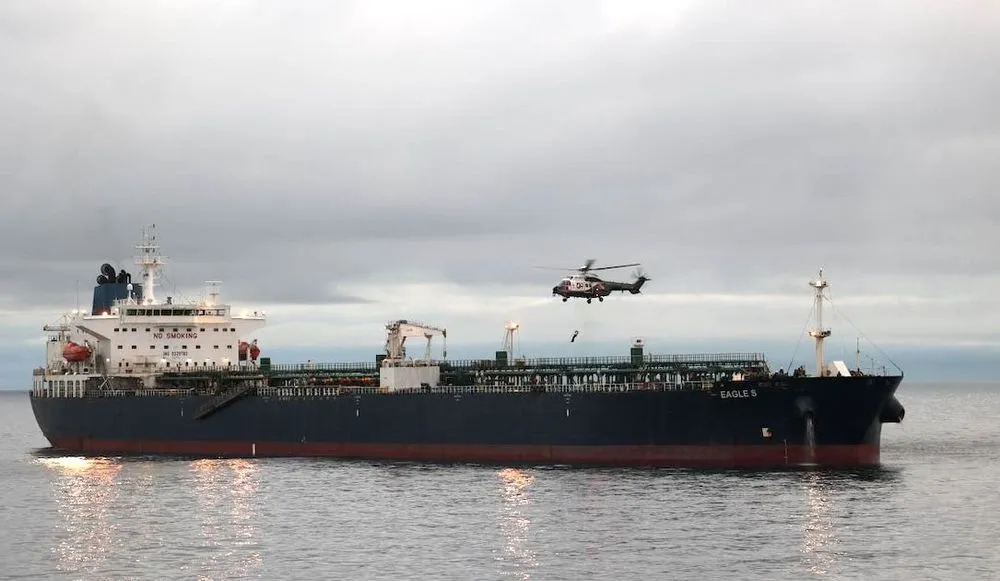Finland identifies seven suspects among crew of alleged Russian 'spy' tanker
Finnish authorities have identified but not arrested seven suspects among the crew of an alleged Russian spy ship that was seized after breaking several submarine cables in the Baltic Sea.
It follows the seizure of the Eagle S, an oil tanker that departed from the Russian port of Ust-Luga on Christmas Day, is suspected of intentionally dragging its anchor for several miles resulting in the complete severing of multiple cables, including the Estlink 2 power cable and four telecommunications cables.
The names and nationalities of the suspect crew members were not released by the National Bureau of Investigation (NBI), but in a statement on Tuesday a senior officer said those staff members had been subjected to a travel ban so they could continue to be questioned.
“A travel ban is a less severe coercive measure limiting personal freedom than apprehension and arrest, and it is imposed to ensure that the criminal investigation is not compromised and that the parties can be reached during the investigation,” said NBI Detective Chief Inspector Elina Katajamäki.
“However, further information is gathered as the investigation goes on, so it is possible that the number of those subjected to a travel ban will change,” added Katajamäki.
Shortly following the cables being broken on Christmas Day — the same day the ship set sail from the Russian port of Ust-Luga — the Finnish authorities dispatched armed units to board by helicopter. The crew did not resist, and the Eagle S was seized by the NBI on suspicion of aggravated criminal mischief and aggravated interference of communications.
The police also seized devices related to the vessel's passage, and the data contained in them is being analysed, the NBI said. Officers have also questioned the Eagle S crew. “The purpose is to create an overall picture of what has happened on the board, and the questionings have been carried out in good cooperation with the crew,” the NBI stated on Monday.
“A crime scene investigation is underway, and the interviews of the staff continue today,” the agency added on Tuesday.
According to a report from shipping journal Lloyd’s List, the Eagle S previously had “abnormal” equipment on board that the publication’s source suspected had been used to monitor NATO naval and aircraft radio communications, and to drop “sensors-type devices” in the English Channel.
The Eagle S has now been transferred to the oil port of Kilpilahti in Porvoo, east of Helsinki. “The authorities have taken care of the maintenance of both the vessel and the crew during the investigation,” explained Katajamäki. The NBI said its investigation may take several weeks or months to complete.
NBI officers also recommenced on Tuesday underwater investigations that had been halted due to bad weather. Using a remotely operated submersible vehicle to photograph the seafloor, they discovered evidence that the ship's anchor had been dragged for several miles along the route of the broken cables.
“With the underwater operations, we have been able to identify the dragging track at the seabed from the beginning to the end. The track is dozens of kilometres in length. For the time being, the possible location where the anchor came off has not been established,” said Detective Chief Inspector Sami Paila, the NBI operation’s tactical lead.
“The investigations are being carried out in the vicinity of the previously photographed dragging track,” the NBI stated on Tuesday.
The incident, which comes amid heightened concern over a range of Russian sabotage and subversion activities, is the latest to highlight how vulnerable subsea cables are to sabotage as well as to accidental cuts.
Sweden, Germany and Lithuania have all launched criminal investigations following an incident in November in which a Chinese ship allegedly damaged telecommunications infrastructure. That month, the United Nations and other international agencies created an advisory body focused on the protection of submarine cables in the wake of dozens of incidents in which they were broken.
Alexander Martin
is the UK Editor for Recorded Future News. He was previously a technology reporter for Sky News and is also a fellow at the European Cyber Conflict Research Initiative.



